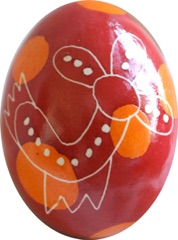Berehynia
Kucheri

Berehynia
Kucheri
The most common depiction of the great goddess is a composition containing “kucheri” (curls). The berehynia may be seen perched on a curl (left), or a curl may be given wings (right). Sometimes one curl is mirror-imaged, giving an “S” shape with wings. Often there is a crown on the berehynia’s head. These compositions are given the folk names of “queen,” “princess,” “scythe,” “drake,” or simply “wings.”

What differentiates a berehynia motif from s serpent motif, which can also be a curl or an S shape with a crown, is the presence of the “wings.”

These are two examples from Binyashevsky:


And here are a few traditional examples from my own collection; these are of the “curls with crowns” type:



And these are of the doubled curls (mirror-imaged) type. Note the “wings” between the top and bottom curls; this cross-piece differentiates between the zmiya symbol (a simple S) and the berehynia (a crossed S).


Lastly, this is an example of a berehynia perched upon the zmiya; you can see the traditional berehynia, with her six arms, and she is above a zmiya. She is a goddess of the heavens, and the zmiya is the god of the earth. Above them both is a sun:

The Goddess, Abstracted

